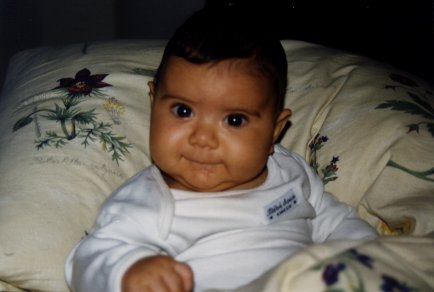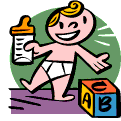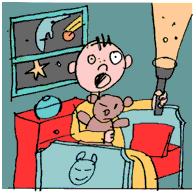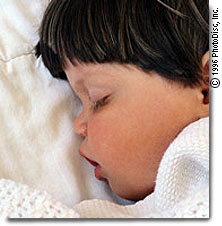NOCTURNAL AWAKENINGS AND INSOMNIA IN THE FIRST THREE YEARS OF LIFE
|
|
A Leaflet written by Dr. Oliviero Bruni Child Neuropsychiatry Unit Ospedale Sant’Andrea Sapienza University of Rome Via di Grottarossa 1035 – 00189 - Rome Tel. (06) 33775859 For
further information, advice and consulence write
to: oliviero.bruni@uniroma1.it |
|

These questions and many others torment 30% of pre-school aged
children’s parents. In fact one in three children suffer from some form of
sleep disorder. A child with a sleep
disorder rarely suffers alone, the entire family is involved and often loose their sleep as well.
The sleep-wake cycle in neonates is very different to that of
adults. In fact during the first months
of life babies don’t recognise the difference between day time and night time.
Their cycle is independent of their environment, and is regulated by the babies
internal needs, like hunger and thirst, and lasts around 25 hours. During the
first months of life being with a baby means adapting your own cycle to theirs
and trying not to resist or modify habits in order to continue to do the things
that you did beforehand.
During the first 4 months of life the mothers sleep-wake cycle must
follow that of the child. After about four months the opposite gradually starts
to happen; babies progressively adapt to external rhythms. This is a
fundamental step in a child’s development. Regular habits facilitate the
synchronisation between babies endogenous rhythms with external rhythms and
consequently sleep is concentrated during the night time. Good sleep is a
condition learnt in the first months of life. It is of fundamental importance
that parents understand how sleep organisation develops in their children in
order to adapt themselves to their child’s rhythm, to know when and how the
babies rhythm’s should be modified and when they should be respected.
|
Common replies given
to parents by paediatricians |
Errors and common
parental misunderstanding |
|
|
|
How to help your baby sleep at
night |
|
|
|
|
Consequences of sleep disorders |
|
|
How to rest? |
|
|
Childhood sleep hygiene principles (useful parental advice to get the child to adapt to a regular sleep
rhythm) |
|

The
sleep–wake cycle in newborn babies and
children
New born babies don’t know the difference between night and day; they
often need to eat, with a rhythm modulated by hunger of between 3 and 4
hours. Subsequently it doesn’t matter
what time of day or night it is, babies frequent awakenings are modulated by a
feeling of hunger and satiety and also seem to be determined genetically. Sleep
is made up of cycles that repeat themselves regularly during the night. The
length ant the structure of these cycles varies with
age. A Child’s sleep cycle is much shorter than that of an adult and new born
babies have a greater quantity of light sleep than adults do. The cycle in new
born babies, is made up of an initial phase of active sleep or REM* and a
following phase of calm sleep or non-REM sleep. During the first two months of
life this cycle lasts about 50 minutes and is evenly distributed in 24 hours.
If 3 or 4 cycles follow on one to another the child will sleep solidly for 3 or
4 hours. In the arc of 24 hours the new born baby will follow 18-20 cycles
without taking into account the day or night time. At around 6 months these
cycles last for around 70 minutes and are concentrated mainly during the night
time; even at this age non-REM sleep begins to differentiate into the different
phases of light sleep and deeper sleep. Gradually the cycles get longer until
they arrive at being about 90 – 120 minutes long and repeat themselves 4 –5
times a night as in normal adult sleep that lasts around 8 hours.
*REM sleep (Rapid Eye Movement: because in this phase
one can see sudden eye bulb movements; look at your child's eye lids when they
are asleep and you will see these movements; they correspond with the period of
sleep in which you dream, our brain is active whilst are body’s
are practically motionless)

During active sleep, babies often present eye
movements, small visual movements, and innate visual expressions such as
fright, surprise, anger and joy. Facial expressions, big smiles or small jolts
are all signs of the underlying cerebral activity taking place that is
associated with the learning of emotions and the ability to communicate.
During calm sleep the child moves very little, the face is very
inexpressive, there are no eye movements but sometimes sucking movements are
observed.
Sometimes a child may make noises or babble while asleep, erroneously
leading parents to believe that they’re awake. A baby is awake when they have
their eyes wide open, follow movements with their eyes and are ready, when calm
to communicate (calm wakefulness) while in active wakefulness babies may wail,
make faces, move their arms and legs, bend double, and sometimes cry loudly and
are very difficult to comfort.
New born babies sleep between 16-18 hours a day and sleep is distributed
evenly through out the arc of 24 hours. (Figure 1).
However there are big inter-individual differences. It’s already possible at this age to see who
will be a brief or a long sleeper: some babies sleep for 20 hour while others
need only 14 hours; some begin to sleep continuously all through the night
while others wake up every 30-60 minutes.
It should also be taken into consideration
that today's children probably sleep far less than children born more than a
decade ago. Recent research on the amount of sleep in children of Rome found
that they sleep far less than the amount considered to be normal in other
international studies.
During the first months of life babies structure and define their own
circadian rhythm. This happens very gradually, without brisk variations or
sudden modifications. If we evaluate the development of sleep we can see how
the most important modifications happen during the first 6 months of life,
while the differences that happen afterwards are minimal:
- Between
1-6 months the day - night rhythm
appears. A period of wakefulness distributed in the late afternoon and
evening appears and there are progressive modifications in the circadian
rhythm of body temperature, of heart and lung activity and of hormonal
secretion. At an encephalographic
level, sleep matures and becomes gradually more similar to that of an
adult.
- Between
4-6 months, babies begin to be influenced by the light-dark rhythm, they
start to sleep continuously for about 6 hours during the night and manage
to stay awake for longer periods during the daytime. The total quantity of
sleep is usually between 12-14 hours and is prevalently distributed during
the night time. The first sign of the circadian rhythm appears between 3-4 weeks and is
characterised by a long daily phase of wakefulness between 17.00 and
22.00. During these moments the child is often in a state of active
wakefulness and presents uncontrollable crying, which can be recognised or
associated with hunger or abdominal pain (colic).
- Between
6 months and 4 years of age, the total time spent sleeping is
progressively reduced to about 10-12 hours and consequently the child
spends more time awake; at 1 year a child sleeps 13 hours a day, between
3-4 years they sleep 12 hours a day,
- Day time napping is frequent in neonates
and gradually decreases with age. From 3-4 naps a day at 6 months to 2
naps a day at around 12 months. At
about 18 months children tend to have just one long afternoon nap.
- At
around 9 months there is an increase in the frequency of nocturnal
awakenings between 21.00 - 24.00 and 3.00 – 6.00 (84% of babies wake up at
least once) which often continues up until 2-3 years of age. While the
child is gradually gaining more consciousness of the world around them,
external stimulus can start to disturb them and their imagination more
often during the night, this is translated into dreams and nightmares
which can start to interfere with sleep.
- Between
the ages of 5 and 12, sleep is at it's best
period and there is a better capacity for being vigil ant attentive. Sleep
develops towards an adult pattern lasting between 8-9.5 hours. Daytime
napping disappears and sleep structure becomes more stable. Falling asleep
becomes faster and while the time to wake up remains stable the time to go
to bed becomes progressively later.
- During
adolescence, sleep lasts around 8-9 hours a day. Sleep rhythms at this age
are often influenced by social habits. It is not unusual that sleep is suddenly reduced to 2-3 hours a
night which determines a sleep debt associated with a physiological
increase in day time sleepiness caused by hormone modifications. Often
daytime napping reappears during the adolescence. (In 23% of adolescence’s
between 15-18 years old).
|
|
Is it normal that my child doesn’t sleep very much during the daytime?
Our children shouldn’t be constantly stimulated, they also need the
calmness, serenity and stability. Today even more so than a decade ago, we
should learn to respect children’s rhythms and provide a protective environment
for them to live in. The more stimuli that they receive the less quiet and the
more agitated and hyperactive they will become during the day.
Why do children sleep so
much?
One of the functions of sleep in small children is associated with brain
development. During sleep the necessary hormones for the child’s growth are
produced and information received during the day is consolidated so
subsequently they learn. The new-born baby is an extraordinary being and is in
a constant state of learning. The elevated necessity to sleep is parallel to
the intense growth that happens at this age.
Where and
how should my child sleep?
In the first few months of life the child’s cot should be placed along side the parent’s bed. The child’s room is too far
away when the child wakes up so often to feed. There are different schools of
thought as to whether or not a child should be allowed to sleep in the parent’s
bed; many parents are frightened of hurting their child by mistake while
asleep; some researchers believe that babies who have physical contact with
their mothers while asleep have improved psycho-physical development and that
it prevents “cot deaths”. Having decided where your child is going to sleep,
it’s a good idea to always put the child to bed in the same place both at night
and during the daytime. (e g. Don’t let the child sleep in the pram or
pushchair during the day to then put them to bed in their cot during the night
time). It is also better to try to get the child to fall asleep on their side
or on their back, avoiding that they fall asleep on their tummy, unless there
have been given specific instructions to do so (paediatrician’s advice etc.).
Between the 4th and the 7th month babies acquire the
ability to move themselves and turn over and will choose themselves the right
position in which to sleep.
Why do some babies sleep all through the night while others wake up
continuously?
There is definitely a genetic component involved: ask your grandparents
how you parents slept when you were small and you will often hear about
experiences similar to those that you’re going through at the moment. As with
adults some babies need less sleep (short sleepers) while others need more sleep
(long sleepers); some babies are less active during the evening and wake up
full of energy while others never want to go to bed at night and have
difficulty waking in the morning.
When a child wakes up during the night it’s extremely important to be
patient; don’t run to the child straight away but wait a second; try to judge
the intensity of the child’s crying and try to resist. When you go near the
child avoid switching on lights or
picking them up, it’s far better to comfort them with a calm, soft tone of
voice and a few caresses while their still lying down. If it’s not an absolute necessity, avoid
giving your child camomile tea, milk or similar beverages; leave the room
before the child’s completely asleep. By following these guidelines you can
avoid becoming the only way of getting your child to fall asleep.
At what age do babies start sleeping without waking up during the night?
In general babies of around 4-6 months
start sleeping all through the night but there is a lot of individual variability.
The most important thing to do at this age is to regulate the child’s timetable
by making sure that bed time, getting up time and meal times are always at the
same hour of the day. Another important thing to do is to make sure that the
child has contact with daylight and
plays during the day, while they do less activity and avoid intense light
during the evenings.
Why does my child start crying inconsolably in the evening?
At the same time as the child acquires a circadian rhythm and adapts to
the light-dark cycle, the child who lives a calm and regular day can often
become nervous and start crying during the evening. In the first months these phases are often
associated with abdominal pains or gaseous colic. It is still unknown whether
or not the child really has abdominal pains however it is clear that children
effected intensely by this disturbance will have more difficulties sleeping.
Crying and irritation in the evening are normal manifestations of the
maturation of the mechanisms that predispose sleep. They’re associated with the
normal phase of hyperactivity at the end of the day which corresponds to an
adult’s day time phase of maximum vigilance. The first sign of circadian
rhythmically appears between 3-4 weeks and is associated with a long daily
phase of wakefulness between 17.00 and 22.00.
Some children go through a light and brief
phase of wakefulness, while
others have a longer phase that can go on until late at night; others again
wake up later in the evening. During these phases the child’s circadian rhythm
is stabilising itself and therefore the correct handling of the child’s
agitated state is very important. By
providing the child with a tranquil environment, by avoiding intense light and
stimulating or rocking the child, you can give your child the opportunity of
falling asleep by themselves.
Should I give my child something
to drink or to eat every time they cry?
In the first weeks of life the rhythm of the new born baby is regulated
by internal necessities so it could be
right to feed them every time they wake
up . After about 4-6 months babies no longer need to feed during the night if
they have regular meals during the day. Therefore you shouldn’t give your child
food or beverages if they wake up during the night. The large quantities of
liquids that some children drink at night (especially herbal infusions) will
often lead to bed wetting and consequently more frequent awakenings and crying. Moreover a bottle will become the only way of
getting the child to fall asleep and often they’ll wake up at night because
they’re used to having a drink.
Should I use syrups, herbal infusions etc. to help my child get to sleep?
NO.
Are there key moments for the acquisition of good sleep during my
child’s development?
Yes, there are 2 developmental moments that are extremely
important for a correct circadian rhythm and good sleep.
- At
around 3-4 months, babies start to be influenced by environmental stimulus
and gradually adapt to the 24 hour light-dark cycle. The child should be
exposed to direct day light during the day and stay in a darker
environment during the night. As
mother or father come home from work, the evening can become a moment in
which the child plays and gets excited, however it’s better that external
stimuli are reduced during these hours. It is therefore important to
install a regular timetable for bed time and getting up time.
- At
about 8-9 months babies develop a fear of strangers and their separation
anxiety increases, both of which are part of a normal
developmental phase. This phase is
often associated with a physiological increase in night time awakenings (
see the section on separation anxiety )
What should I do if my child has difficulty falling asleep?
Try to install fixed rituals that
the child associates with relaxing and bed time. Singing a lullaby or changing
and washing the child can be a good signal for the child. Always try to put the
child in their bed or cot when they’re still awake and give the child time to
fall asleep by themselves. By 4-6 months you can already start putting these
guidelines into practise. Before picking
the child up when they move, make noises or cry it is very important to wait
and see what happens. It is important to give babies time to communicate what
they want. Often (hopefully) the child will fall asleep by itself without help. If the babies difficulties are
persistent and the child “fights against
sleep” then you could try a gradual extinction technique (see section on night
time awakenings).
At about
8-9 months babies develop a physiological increase in night time awakenings
associated
What should I do if my child suffers from multiple night awakenings?
Children and parents have different ways of reacting to bed time and night time awakenings making it
impossible to give sound advice without taking into consideration the
particular child and it’s parents. Apart from “minimal checking” another
general technique to try is that of “gradual extinction”. By taking one small
step at a time one tries to help the child acquire the desired behaviour. For
example by getting the child used to being progressively further away from
parents when falling asleep or when they wake up at night. If the child starts
crying or calling; wait 30 seconds before going to calm them down, keep
reciprocal interaction to a minimum and leave the room when the child’s still
awake. The time you wait before going to
calm the child down should be progressively longer every time the child calls
out again. Passing from 1 to 2 minutes etc. Until the child manages to fall
asleep by itself. The following night the time you wait before going to calm
the child down should be doubled etc. After about a week things should get
better. Always put a small light in the room and provide the child with the
possibility of controlling its immediate surroundings. Don’t feel guilty when your child cries and
you don’t interfere because your not creating any
sort of psychological trauma. If you persist and are constant in the use of these techniques you will gain
the desired results.
|
A Leaflet written by Oliviero Bruni Center for Pediatric Sleep Disorders University of Rome “La Sapienza” Via dei Sabelli 108 - 00185 - Rome Tel. (06) 44712257 e-mail:
oliviero.bruni@uniroma1.it |



